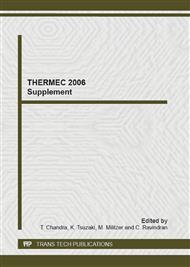p.816
p.822
p.828
p.834
p.840
p.846
p.852
p.858
p.864
Microstructure - Texture Related Toughness Anisotropy of API-X80 Pipeline Steel
Abstract:
The dependence of Charpy toughness on the microstructure and texture of two industrial grades of API –X80 pipeline steel with a thickness of 15 and 17 mm, respectively, were studied in this work. Standard size Charpy samples with a long axis orientated at 0, 22.5, 45, 67.5 and 90° with respect to the rolling direction of the plate were tested at different temperatures varying from -196°C to 20°C. Microstructure and texture of the plates were studied by means of electron backscattering diffraction (EBSD) and XRD. The highest value of the absorbed energy (440 J) was measured at room temperature in the samples oriented with the long axis parallel to the rolling direction and the minimum values for the same temperature were observed in the samples enclosing an angle of 45° to RD (340J). Statistical model parameters obtained from Charpy impact tests were quantitatively correlated to microstructural parameters by means of a linear regression model with the aim to describe the Brittle-Ductile Transition Curve in terms of microstructural features. Based on dedicated experiments the Brittle Fracture Factor (BFF) parameter was introduced, which quantifies the fraction of the {100} planes oriented parallel to the crack propagation front. It was found that the Charpy toughness anisotropy of the plates in the lower shelf region can not be related only to their crystallographic texture, but to the microstructural anisotropy characterized by the grain size variations i.e. the density of grain boundaries in the different directions. Also the spatial distribution of the 2nd phase plays a determining role in the fracture behavior.
Info:
Periodical:
Pages:
840-845
Citation:
Online since:
February 2006
Keywords:
Price:
Permissions:
Сopyright:
© 2007 Trans Tech Publications Ltd. All Rights Reserved
Share:
Citation:


